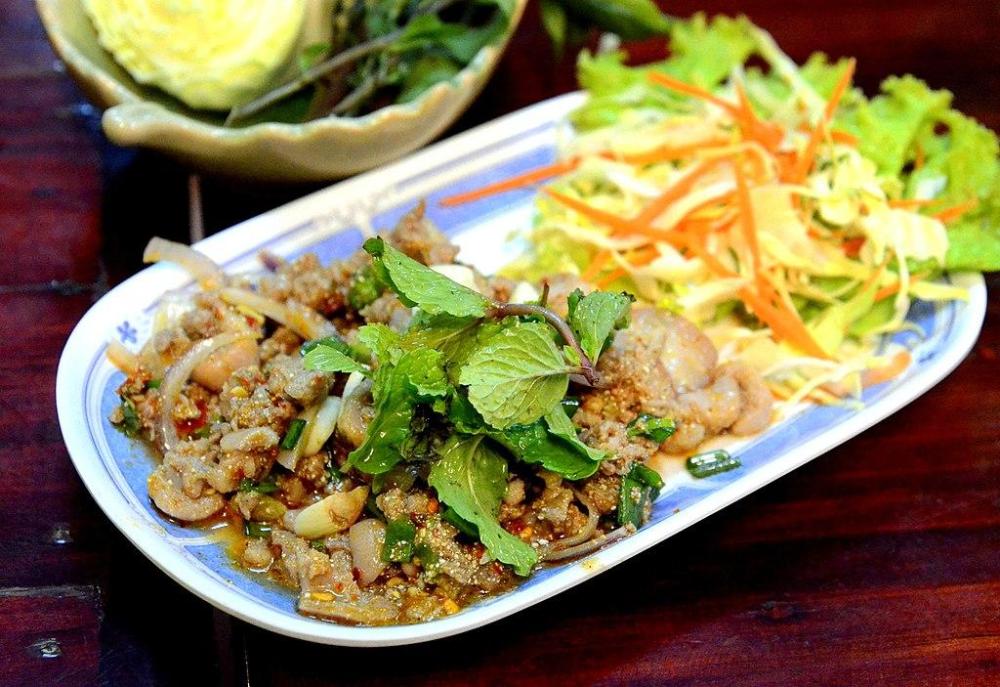Some Highlights of Poultry Blood around the World
2. SOUTH-EAST ASIA
Much of SE Asia has been influenced by Chinese cuisine and poultry blood appears there, too. It is often used in noodle dishes in Thailand, home to China’s largest and oldest emigrant population. In Bangkok’s famous Don Wai floating market you wind past pots of congealed duck blood and, should you stop for a bite, among the dishes on offer are noodles with spicy duck blood or plates of stewed blood to have with rice. The spices used are very reminiscent of those in 5-spice powder, showing the Chinese influence.
In 2015, chicken’s blood was briefly banned by the Thai government after around 100 people suffered food poisoning in Changmai after eating the popular dish ข้าวมันไก่ (khao man gai, a Thai version of Hainanese Chicken) infected with the bacterium Vibrio parahaemolyticus. After investigating, the authorities announced that the outbreak had been caused by the dish having been cooked then left sitting around for hours waiting for someone to order it. I have few rules about my restaurant eating, but I never eat dishes that are pre-cooked and laid out buffet style in Asia.
Khao Man Gai - Image by Calliopejen, licensed under the Creative Commons Attribution-Share Alike 4.0 International, 3.0 Unported, 2.5 Generic, 2.0 Generic and 1.0 Generic license.
The authorities stressed that the dish, which often contains chicken blood tofu (see above) must only be served when freshly made and hot. A Dr. Sopon Mekthon of the Department of Disease Control confirmed Vibrio parahaemolyticus had been found only in the chicken blood tofu. People could still eat chicken but should avoid blood tofu, which is not sterilised. He also recommended that cooks use separate knives and chopping blocks for chicken blood tofu from other equipment to prevent food poisoning.
Neighbouring Laos sensibly prefers its ducks. ລາບ (laab, larb, larp, laap, larp or lahb all are alternative spellings), meaning 'salad', is the national dish in Laos and laab baeng pet or colloquially ‘paeng pet’ is a kind of duck salad with blood. It comes in two versions, cooked or raw. The people of Laos have a love of raw meats and prepare the salad with raw duck meat, not somewhere I advise you to follow. The cooked version of the salad also contains raw duck blood but give it a go. It is an amazingly delicious dish and you’ll soon stop worrying about what you are eating. The dish also contains minced / ground duck meat and copious amounts of fresh herbs. Finished with peanuts, green onions, chopped chillies, and crispy fried shallots, this is a dish to remember. True heroes will cover their dish of laab with freshly squeezed lime juice – the limes are there on your table waiting, then take a raw chilli (also waiting) and dip it into the shrimp paste provided to consume as a chaser.
Lab Baeng Pet - licensed under the Creative Commons Attribution-Share Alike 3.0 Unported license.
In Malaysia, curry mee often contains duck blood, although in some places, especially Penang, they use pig blood instead. Check, if that is an issue for you. The dish is made with rice noodles in a spicy broth with coconut milk and seafood along with cubes of coagulated duck blood.
Last but far from least, Vietnam also uses blood extensively. It features in noodles from Hue, the ancient capital, and they have their own version of blood sausage, similar to the French boudin they encountered in colonial times. Blood congee is sometimes eaten for breakfast. But their most famous poultry blood dish has to be tiết canh vịt or duck soup made by mincing duck neck (including the bone) and boiling that with the bird’s liver, gizzards and anything else they find inside except the muscle flesh. It is finished with the duck’s blood which has been kept liquid by the addition of lemon juice and nam pla, fish sauce. The bright neon-red soup also contains grilled onion, saw-leaf herb, basil, lemon leaves, and chilli and is topped with the boiled liver and peanuts. As ever in Vietnam, it will be served with a side of green herbs and lemon.
Tiết Canh Vịt - Image by Petr and Bara Ruzicka, licensed under the Creative Commons Attribution 2.0 Generic license.
I miss Vietnamese food so much!
...to be continued








